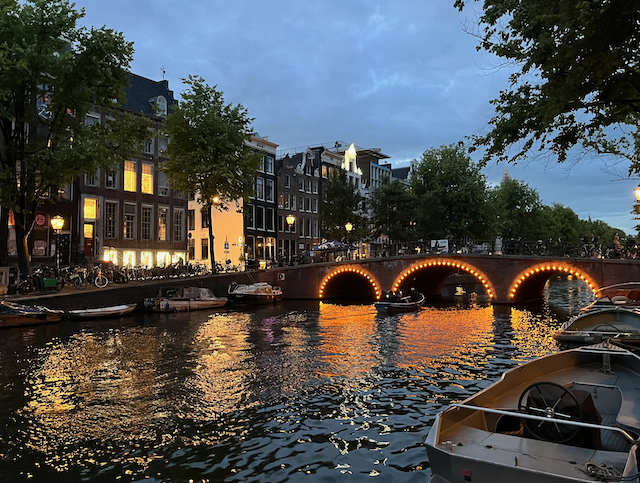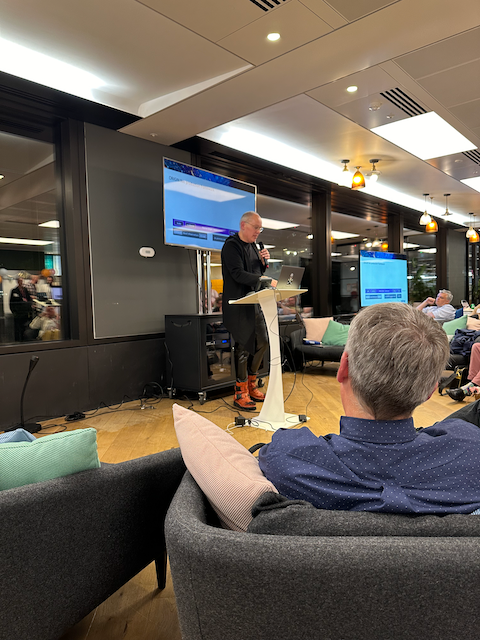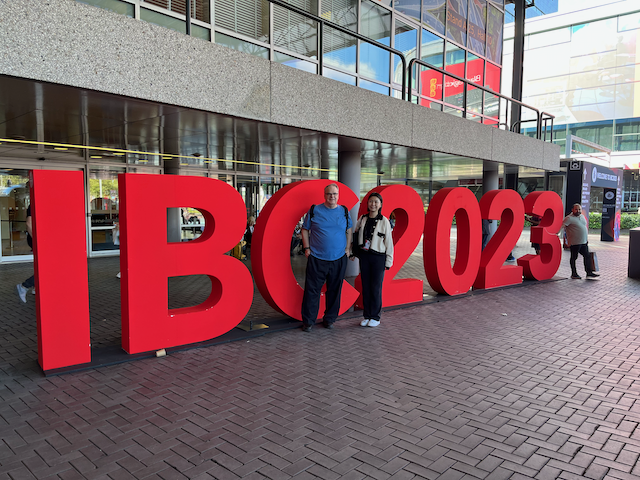Recharging after IBC
We're taking our post IBC vacations, but here is a recap of our activities prior to and during the show and a look forward to what's next.

SMPTE UK visits AWS
A few days before IBC, Mike attended the SMPTE UK meeting at AWS in London during a heat wave. Mike said it felt a bit strange to be a guest in an AWS building, but it was a good meeting.
There were two speakers at the meeting:
- Ian Fletcher, the new CTO of Grass Valley Group, discussed their AMPP platform and how it is being used to enable cloud production workflows.
- Richard Cartwright, technical leader at Matrox, discussed their new Origin framework for cloud production.
AMPP
Ian's talk was an overview and demo of some parts of the AMPP system, and he said it was being used by a large number of customers, including Prime Video who were in this same building in London. It was interesting to hear that a majority of customers are using AMPP to control their ground-based systems rather than doing production in the cloud. He showed a typical setup which linked several production trucks for a sporting event. Using the WebRTC GUI he could observe and control the equipment in the trucks.
When discussing AMPP for cloud production he was mentioned how efficient their system is at packing lots of processing operations on a single GPU based instance. This makes Mike cringe because he is always thinking about blast radius: how much of your system is affected when something goes wrong. If you have a single instance doing a lot of work, then if that instance fails you lose a lot of functionality. This is why we are designing our system to be more distributed, so that if a single instance fails you only lose a small part of your functionality, and we can repair small parts like that quickly, so there is no interruption in service. We can manage this in a cost effective way because we can use smaller, cheaper instances, and we can use spot instances to reduce costs even more.
Matrox Origin
Mike has seen Richard speak about Origin all over the world, and by now could almost be considered a "stalker." It is interesting to see who attends and asks questions at these events, because it is a good indicator of who will also be interested in our service. And of course we want to see how they are reacting to the Matrox asynchronous processing model.
Perhaps because this was a SMPTE event, there was a discussion about what parts of Origin could or should be standardized. I don't think there were any strong conclusions, but it is good to see that people are thinking about this. We'll talk more about Origin below in the IBC section.

On the following day Mike took the Eurostar to Amsterdam while Jialu and her family flew from Portland to Amsterdam. It was finally time for IBC.
IBC

Jialu applied for her visa early enough this year to be able to attend her first IBC. And she brought her family, because we decided to each take vacations beginning the day after IBC.
We had a few goals for IBC: We had a few meetings scheduled, and we wanted to get an impression of how European broadcasters are thinking about cloud production. We also believe we may be exhibiting at IBC next year, so we wanted to get a feel for the show from that perspective.
The show went very well for us. We met a lot of interesting people, and people who could introduce us to others that we should talk to. It was clear that showing up is important for a company at this stage of development.
Here are a few observations from the show:
- There were more people than last year, and it was a larger show. But it did have a sort of muted feeling to it.
- It was great to see all the small Asian companies exhibiting here, since most of them were not able to attend NAB. We got some good leads for things like control surfaces and other hardware.
- We were disappointed with the AWS sponored cloud production talks in the theater. They mainly used a roundtable format, which is not very effective in a large noisy room and is more friendly to the speakers (who don't need to prepare much) than the audience. And the participants were mainly senior executives who were well trained in speaking in non-controversial platitudes. We would have preferred to hear from engineers who could talk about the technical details and lessons learned.
- Many of the booth staff in the exhibits were really helpful and friendly. We learned a lot from just starting simple conversations with them. And so many of them want to help us get connected to the right people in their companies.
- We were looking for hardware that could be used to transfer signals to our service from the ground: for example a gateway / encoder that accepts SDI or ST 2110 inputs and outputs JPEG-XS over some protocol to the cloud. Apparently this is not a priority for most of the vendors, and we were not able to find anything that would work for us. We may have to build our own.
- Mike stated we would spend around 15 minutes at the VSF member reception on the boat used for the AIMS IP Showcase - just a quick hello and we would leave. But soon after we boarded, the boat left the dock! We ended up staying for a while, and had some great conversations with people from the industry. Mike spent much time in a spirited discussion with Peter Brightwell from the BBC about the EBU project for dynamic cloud media microservices. Mike is fairly concerned about parts of this project, fearing that its reliance on the current enterprise IT stack of kubernetes and microservices may make it too limited and expensive to be useful for standardized cloud production in the long term as budgets get squeezed. We hope to present a paper at the next EBU Cloud Production Forum to expand on this.
- We attended the Matrox Origin seminar hosted by Richard Cartwright. It was well attended. He gave a good overview of the Origin architecture and left plenty of time for questions. We found it interesting that most of the questions were about the business model and not the architecture. For us this bodes well if it means people are generally accepting of the asynchronous processing model. And since for us this kind of architecture is just an implementation detail it will not be necessary to explain the business model.
- Our favorite booth had to be bunny.net. When we look at exhibits we noticed that we are attracted to the ones that have animal logos -- expecially cute animal logos. And when we reached bunny.net we knew we had found our people. We had a great conversation with their staff about their swag and their service. They seem to be very good technically as well as having a great marketing team. We will be following them closely.
Compared to last year, it seems like the broadcasters in Europe are more interested in cloud production. But they are still in the early stages of figuring out how to do it. We were told that some of the pioneers are moving back to their data centers because their cloud bills are too high. We think this is because they are trying to use the cloud in the same way they use their data centers, and that is not the best way to do it. We hope to help them figure out how to do it better.
At the show there was much talk about the trend for the near future looking like reducing capital expenses and staff where possible. We think this supports our SaaS based business model. These next few years will be interesting.
Vacations
After IBC Mike went home to Portland and took a mini vacation driving to Los Angeles to attend SVG's Remote Production Forum (more about that in the next blog post). He took his non-Tesla EV on this trip, so he had lots of free time while charging and even got to experience some "range anxiety." But he made it to LA and back without any problems. Now Mike is taking a staycation at home in Portland.
Jialu and her family enjoyed Amsterdam for a few more days and then flew to China. From her initial reports it sounds like they are having a great time and the railway system in China is very impressive.
Our vacations end in time to travel to New York at the end of October. We will say more in the next blog posting.